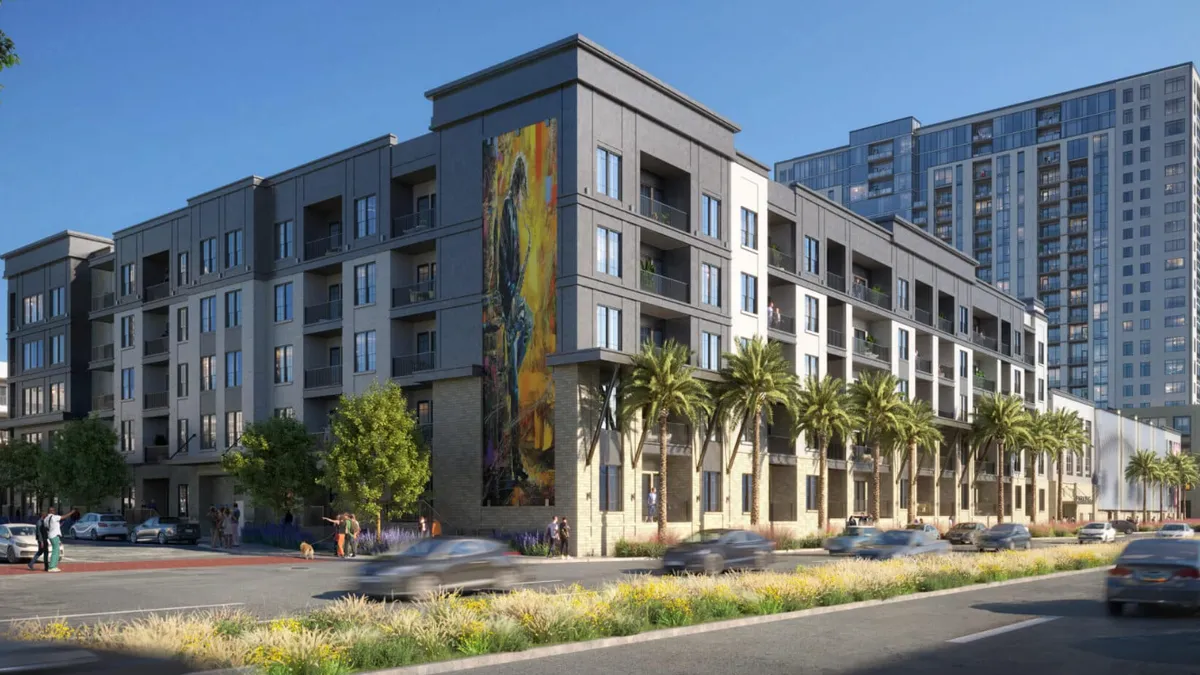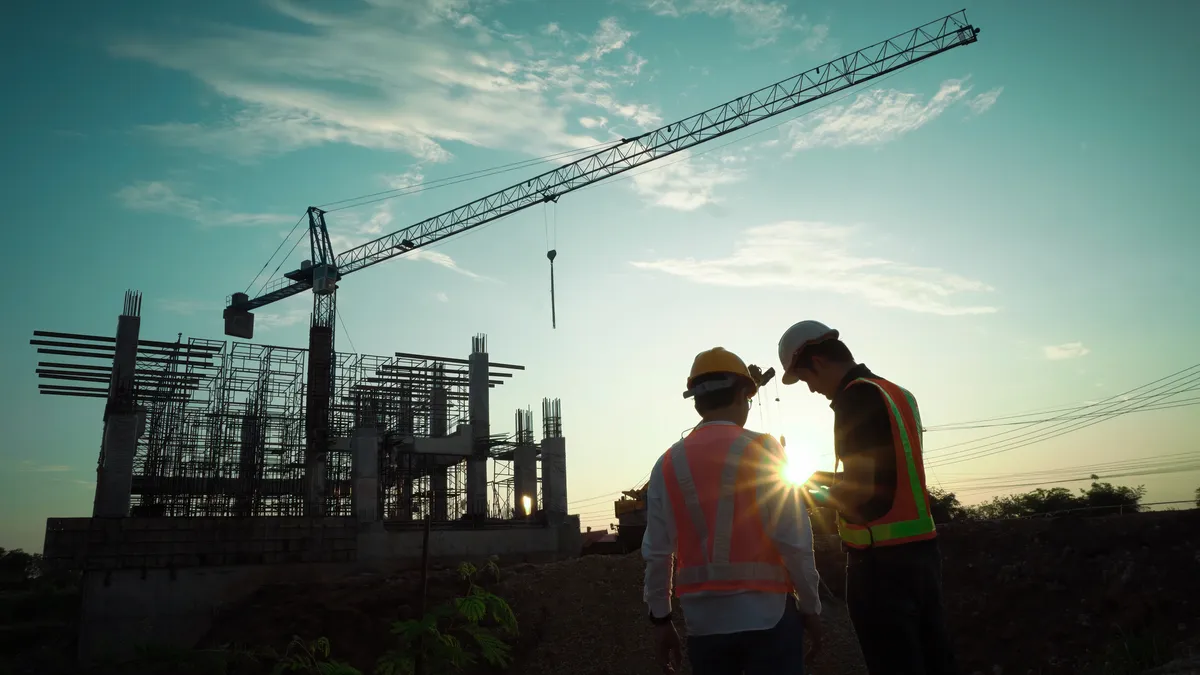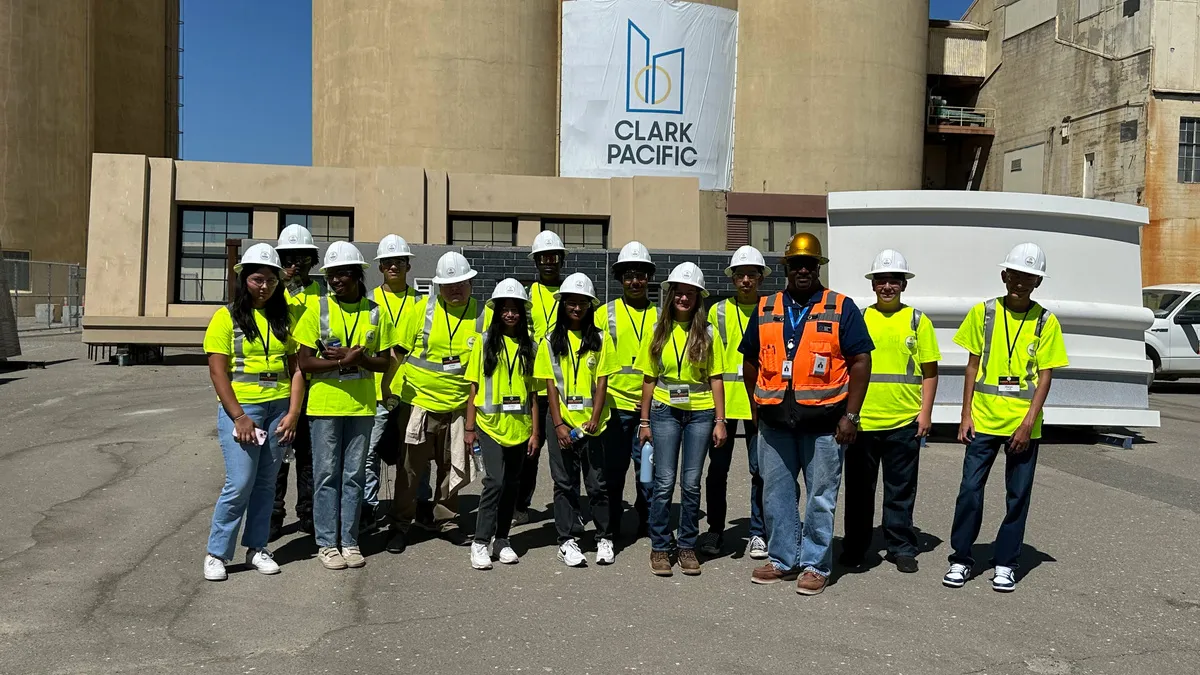When it comes to heralding the advantages of offsite construction, the hospitality segment is checking in newcomers to the method like no other. Though healthcare and multi-unit residential markets offer opportunities for modular, the U.S. hotel pipeline is proving to be the most feasible and the most scalable.
And that impetus is coming primarily from developers looking to get “heads in beds” faster. From boutiques like citizenM, which holds the soon-to-be-upset record for tallest modular hotel, to ubiquitous flags like Hilton and Marriott, owners are more frequently considering modular not an alternative, but an imperative.
For example, though he rolled the dice on the Bay Area’s first modular hotel, BJ Patel, owner and general manager of Home2 Suites by Hilton San Francisco Airport North, said that contracting Guerdon Modular Buildings over a conventional builder ended up being a “no-brainer.”
At the time of conception, Patel told Construction Dive, Bay Area development costs were at an all-time high while labor was at an all-time low, and the firm couldn’t get a contractor to meet it in the middle with a decent quote.
By late 2016, Patel and his associates went to Sacramento to check out a three-story hotel that had recently been built offsite, and from that point he never looked back.
A second look at a modular first
In terms of demand, “It’s one of the best times in the history of construction” for hotel owners, Patel said. But in the California labor market, similar to many others, general contractors’ prices and timelines are tainted by the pinch. So his firm took on the role of GC and booked a trip to Guerdon’s facility in Boise, Idaho.
Guerdon’s approach allowed Patel to open the 155-suite property exactly 16 months after its groundbreaking ceremony, which is approximately a year less than he’d anticipate for a traditional build. The method “cuts down construction time by almost half” in some cases, he said, and from his experience building hotels throughout the U.S. for the past decade, every penny counts when it comes to cash flow and return on investment.
Prefab hotels also promise higher quality than those built in the field, he continued, touting in particular noise-reduction effects that benefit the end user. Six months after opening, he said, he’s received not one complaint about noise.
“Two different boxes sit on top of one another,” he said. “Acoustics-wise, there’s no better way to build a room with such soundproofing,” which is a must for guest satisfaction, especially at an airport location.
But the project didn’t close out without obstacles.
The first, Patel said, was a level of skepticism from city officials that went all the way up to the mayor, considering the approach was new to San Francisco. “We had to take three different trips — with the fire department, the building department and a planning department — to Boise to show them the factory, before they were convinced.”
Getting the project funded wasn’t easy, either. With modular, “you burn money so fast” and there’s a scary amount of risk, he said. “You need to have up to 70% of costs upfront” to set the design and get the assembly lines cranking. Once construction is started, some projects can be completed in as little as six weeks.
As a result, no lender wanted to cough up the money, Patel said. A local bank agreed to taking on 40% of the costs if he put up 60%, but by the time construction had started, the bank was still hesitant, and the firm had to unexpectedly see it through by putting up the rest of the money on its own.
Another big lesson learned, he added, is that not just any subcontractor can jump in on a modular project. “We could have shaved an additional six weeks off the project timeline if we’d had a crew that was experienced with offsite work.”
And with up to 15-inch-thick concrete slabs for the podium, getting a cellular signal through became an unexpected setback that required the installation of signal boosters throughout the hotel.
But Hilton, as the franchise grantor, fully backed the process from start to finish, with its architects understanding the method and providing support. And Patel came out on top, he said.
"At Hilton, we recognize the considerable potential of modular construction, and we are always looking at it as a development option to keep up with the strong demand for our brands when appropriate," Adrian Kurre, Home2 Suites by Hilton global head, said in a statement to Construction Dive. "The primary benefit of modular construction we’ve seen that will thrill owners and developers is the speed of construction."
The offsite construction process was “definitely not cheaper” than it would have been for conventional methods, which is a common sentiment even among modular proponents, and given the amount of capital it typical requires upfront, choosing modular certainly does not pencil out in all regions, Patel said.
"What's important to modularization as a whole is standardization."
Dave Walsh
Senior Director of Project Management, Marriott
But because it helped him generate revenue sooner, and provided an end-around to the labor crunch, modular has become the company’s “first way of thinking” in California, at least, as Patel has already taken on another modular build near the Oakland airport.
Marriott makes the case for modular
Marriott is even more bullish on the method.
Five years ago, it launched a concerted effort to get more of its properties built through modular methods, which has included a quota for amount of modular contracts signed, a minimum percentage of builds being done with at least some form of prefab methods employed, and even up to $250,000 incentives to develop its hotels through modular.
Its 32nd modular hotel, the AC Nomad, also in New York City, will edge out the citizenM to be the world’s tallest when completed in early 2021.
New York City-based Skystone Group has served as the primary contractor for both hotels, outsourcing work to full-volumetric modular manufacturers in Poland, from where individual hotel rooms are shipped in to New York ports fully fitted, fully furnished and ready to “be stacked like Legos,” according to Chief Financial Officer Greg Thompson.
The biggest draw for owners, Thompson said, is cost certainty from the design stage to final closeout, shepherded by a single contracting entity — in this case, Skystone as a GC — with whom to interact from end to end.
And it’s worked well for Skystone so far.
“We’ve pivoted our business to purely modular construction, whereas we would have executed some conventionally constructed projects as well,” he continued. “We’ve received a constant stream of inquiries, a robust pipeline that will keep us busy for years and we’re looking to enter European markets as well.”
A big part of that demand, he said, is coming from Marriott.
“Marriott is recognizing that it needs to dramatically reduce the pace of hotel completion,” he continued. Using traditional construction, Marriott hotel builders are taking around 21 months to complete a hotel, whereas they were doing so in 12 months a number of years back. They’re looking to decrease that timeline and they see modular as part of the solution — whether that’s high rise, steel frame, full-volumetric modular, panelized modular, timber or even just a traditional build that incorporated prefabricated bathroom pods.”
Marriott’s big incentive, launched in 2015, came from the labor shortage and the need to offer something better to franchise owners, Dave Walsh, Marriott’s senior director of project management, told Construction Dive. “The labor was just not coming back after the last downturn and we had to ask, how we do find a way to help our hotel builders construct properties where the labor is just not there?”
Lack of education about modular has been the single biggest barrier, he explained, so Marriott has embarked on a journey to illuminate modular to the AEC world, lenders, municipalities and owners. “It takes a whole different mindset,” he said. “The S curve of procurement is completely different, the lending side is completely different — you need a lot of money a lot sooner.”
Apart from incentives and education, Marriott offers customizable, schematic modular prototypes for five of it brands. “If we’re going to dive this deep into modular, we needed to be able to give our owners a tool that would provide a rough order of magnitude for pricing for a modular manufacturer, which is also quite beneficial to a GC.”
Thinking inside the box
It's still small steps toward a big goal, Walsh continued, but even if a builder wants to harness the quality and efficiencies of prefab bathroom pods by plugging just that aspect of the build into conventional construction techniques, design involvement and education is needed upfront.
And Marriott seeks to help with that by demonstrating that despite all the flair and fittings and specific brandings its offerings encompass, the box — meaning the individual hotel room, in this case — at its core is a box, and standardizing the box is where the efficiencies are realized.
“What’s important to the modular industry as a whole,” Walsh continued, “is standardization.”
Prescient’s CEO Magued Eldaief concurs, so much so that he doesn’t like to refer to his company as a modular builder. “We’re trying to industrialize and standardize the whole process of how you develop any sort of project, especially a multi-unit project, and the hospitality industry fits perfectly into what we do.”
But what Prescient does is different than what most modular builders do, he told Construction Dive. “We take a design and then we snap that design on a 2-foot by 2-foot grid, and we try to automate the whole process of how you would design, engineer and manufacture the components of that unit.”
On the contrary to modular being confined to a collection of ordinary boxes, however, proponents stress that modular actually provides more breathing room for aesthetics. If anything, there can be a more fine-tuned focus on design if the core of the building requires less time, according to construction software company and modular advocate Autodesk.
"Some customers have expressed anxiety about modular and prefab affecting their creative freedom. In reality, many components of a project have a high degree of repeatability and by using a modular approach, architects and designers can focus more on the creative aspects and less on the repetitive elements of a project," said Bob Bray, senior director, Autodesk Construction Solutions. "Modular does, however, require a change in the design process, and we are working with our clients to create workflows supporting the transition to modular."
Aligning with Walsh’s sentiment that a hotel at its core is a repeatable set of boxes, Eldaief said that his firm is focused on the superstructure of a building.
“Our structures are engineered to 1/32s of an inch. So within everything that we would design, just like a car chassis, we know where everything — MEP and other fittings — is going to fit. We enabled that by doing the full design and coordinating all those activities for what needs to be bolted on that building.”
Instead of shipping full-volumetric pods on the site for stacking, he said, Prescient works with kits that can be more easily shipped and assembled on-site.
That type of control dictates the principles of modular design, he said. “You're trying to save costs and you're trying to de-risk a project. And last but not least, you're eliminating waste in every sense — especially time wasted in coordination activities and on the jobsite.”
Stay tuned to this monthly column as it takes a deeper, nuanced and sometimes more critical look at the modular movement, and feel free to email me your thoughts, concerns and ideas on topics to cover in this series.
The Modular Monitor series is brought to you by The Modular Building Institute (MBI), the voice of commercial modular construction.
MBI presents World of Modular, modular construction’s premier international event, in Orlando, March 9-12. Register today.
MBI has no influence over Construction Dive's coverage within this column or other articles, and its content does not reflect the views or opinions of MBI or its employees.

















